Articles
Become a Rolex Expert: Understanding Collections, Waiting lists, and More
This guide is designed to turn you into a Rolex expert. Whether you’re a novice collector or an avid enthusiast, you’ll learn how to identify different Rolex collections and models by sight, understand their unique features, and have the knowledge to start engaging in conversations about them. We’ll also touch on the nuances of pricing and market dynamics, ensuring you can accurately gauge the value of a Rolex watch at a glance. By the end of this guide, you’ll be well-equipped to appreciate the artistry and engineering behind every Rolex timepiece.
Understanding Rolex
History and Legacy
Rolex, established in 1905 by Hans Wilsdorf and Alfred Davis in London, quickly rose to prominence by focusing on precision and reliability. The name “Rolex” was registered in 1908, symbolizing luxury and innovation. By 1919, Rolex moved its operations to Geneva, Switzerland, a city synonymous with high-quality watchmaking.
Key milestones in Rolex’s history include:
- 1926: Introduction of the Oyster, the world’s first waterproof wristwatch.
- 1931: Invention of the Perpetual rotor, the first self-winding mechanism.
- 1953: Launch of the Submariner, the first divers’ watch waterproof to 100 meters.
- 1956: Introduction of the Day-Date, the first wristwatch to display the date and day of the week spelled out in full.
- 1963: Release of the Cosmograph Daytona, designed for professional racing drivers.
Craftsmanship and Innovation
Rolex watches are famous for their exceptional craftsmanship and innovative technology. Each watch is a blend of art and science, meticulously crafted to meet the highest quality standards.
- Materials: Rolex uses only the finest materials, such as Oystersteel (high-performance stainless steel, namely 904L Steel), 18k gold, and 950 platinum. The brand also develops exclusive materials like Cerachrom for bezels and Parachrom for hairsprings.
- Precision: Every Rolex movement is certified as a Superlative Chronometer, ensuring accuracy within -2/+2 seconds per day. This certification is more stringent than the standard COSC certification.
- Durability: Innovations such as the Oyster case, Triplock crown, and Cerachrom bezel ensure that Rolex watches are built to withstand extreme conditions, whether underwater or at high altitudes.
Rolex Terminology
Understanding Rolex-specific terminology will enhance your appreciation and ability to identify different models. Here are some essential terms:
- Oyster: The robust and waterproof watch case was introduced in 1926, the foundation of most Rolex models.
- Perpetual: A self-winding movement powered by the wearer’s wrist motion, introduced in 1931.
- Cyclops Lens: A magnifying lens positioned over the date window, enhancing legibility by 2.5 times.
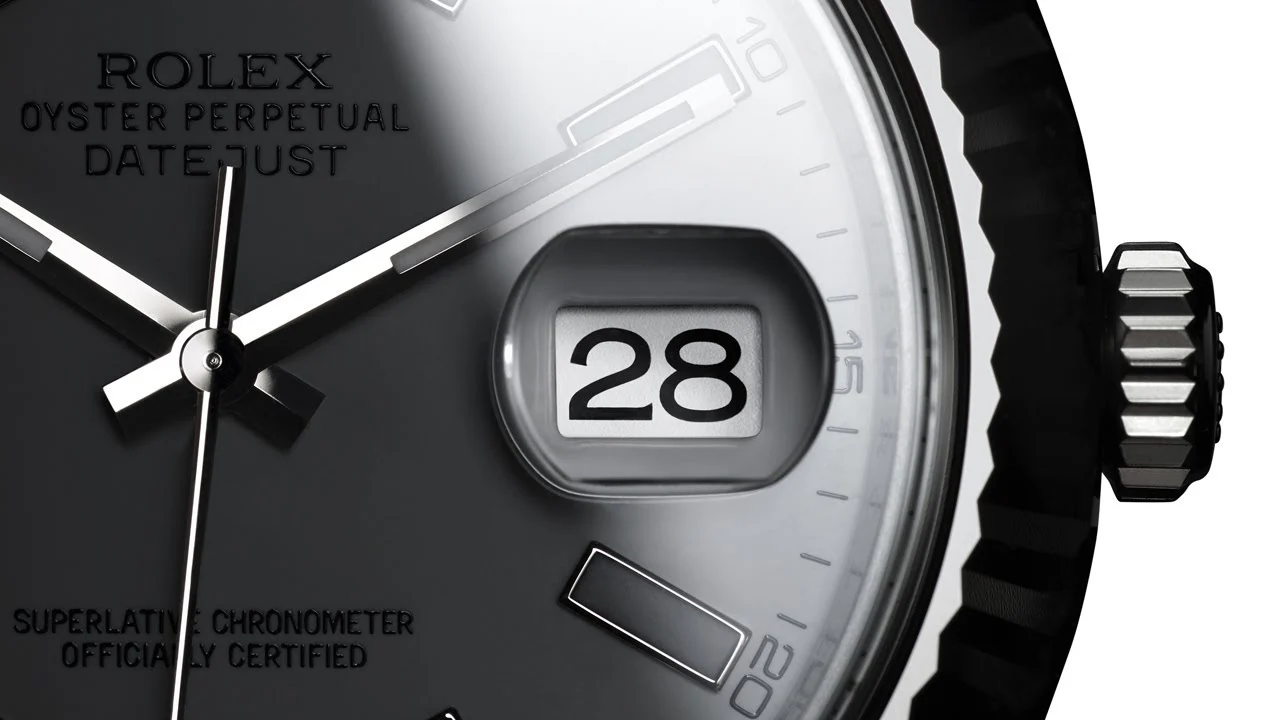
- Rolesor: The combination of Oystersteel and gold (either yellow, white, or Everose) in a single watch, a hallmark of Rolex’s design since the early 1930s.
- Superlative Chronometer: A designation indicating that the watch has passed Rolex’s rigorous precision tests, which are twice as strict as the standard COSC certification.
- Cerachrom: A highly durable ceramic material used for bezels, resistant to scratches and UV rays, ensuring the bezel retains its color and appearance.
- Triplock Crown: A triple waterproof system designed for underwater watches, ensuring water resistance to significant depths.
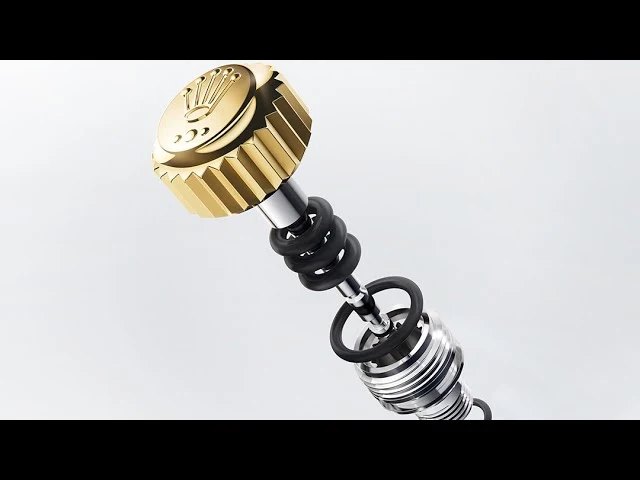
- Parachrom Hairspring: A blue alloy hairspring developed by Rolex, offering greater resistance to shocks and magnetic fields, enhancing the watch’s precision. A very noticeable and defining element of the movement.
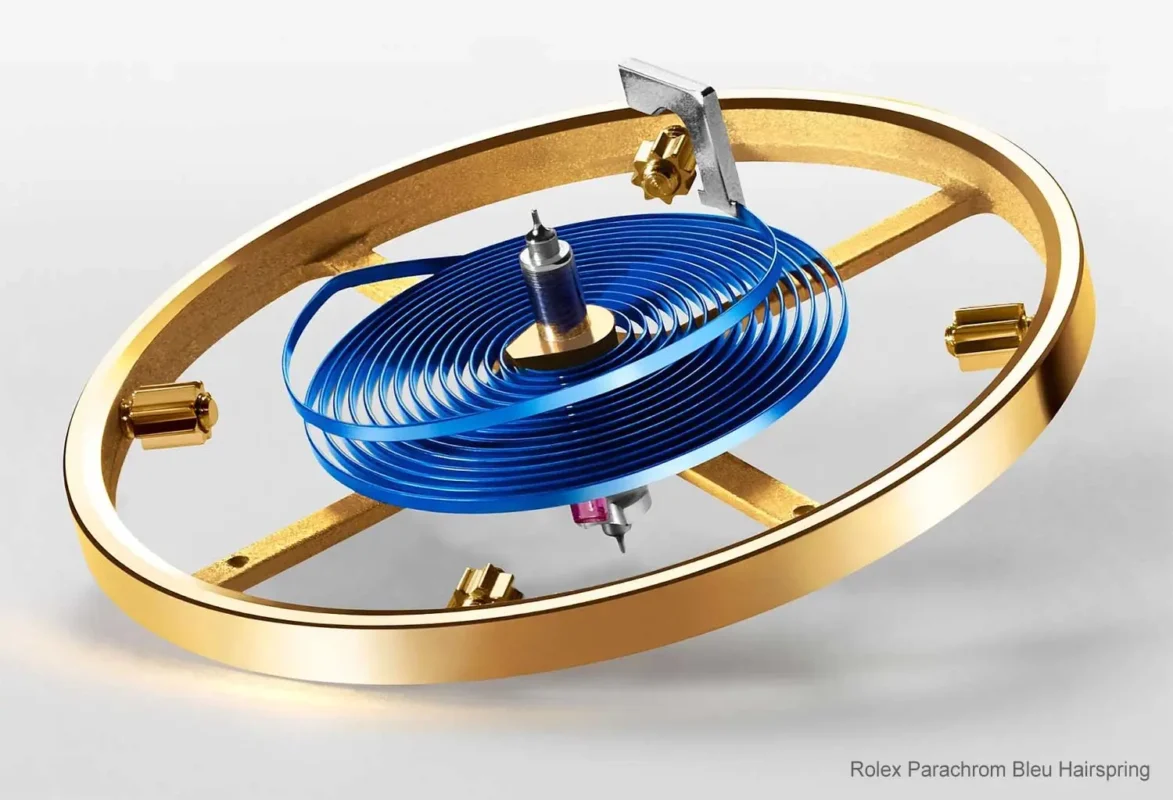
- Helium Escape Valve: A feature in professional divers’ watches like the Sea-Dweller, allowing helium to escape during decompression, preventing damage to the watch.
- Glidelock Clasp: A clasp mechanism allowing divers to adjust the bracelet length easily for a secure fit over wetsuits.
- Maxi Dial: Larger hour markers and hands for improved legibility, featured in models like the Submariner and GMT-Master II.
- Chromalight: A luminescent material used on dials and hands that emits a long-lasting blue glow in low light conditions.
- Ring Command Bezel: Found in models like the Sky-Dweller and Yacht-Master II, this bezel interacts with the movement to set functions like the annual calendar and regatta timer.
- Two-tone: Refers to watches that combine two types of metals, typically gold and steel, in the case and bracelet.
- Jubilee: A five-piece link metal bracelet introduced in 1945, known for its comfort and elegant design.
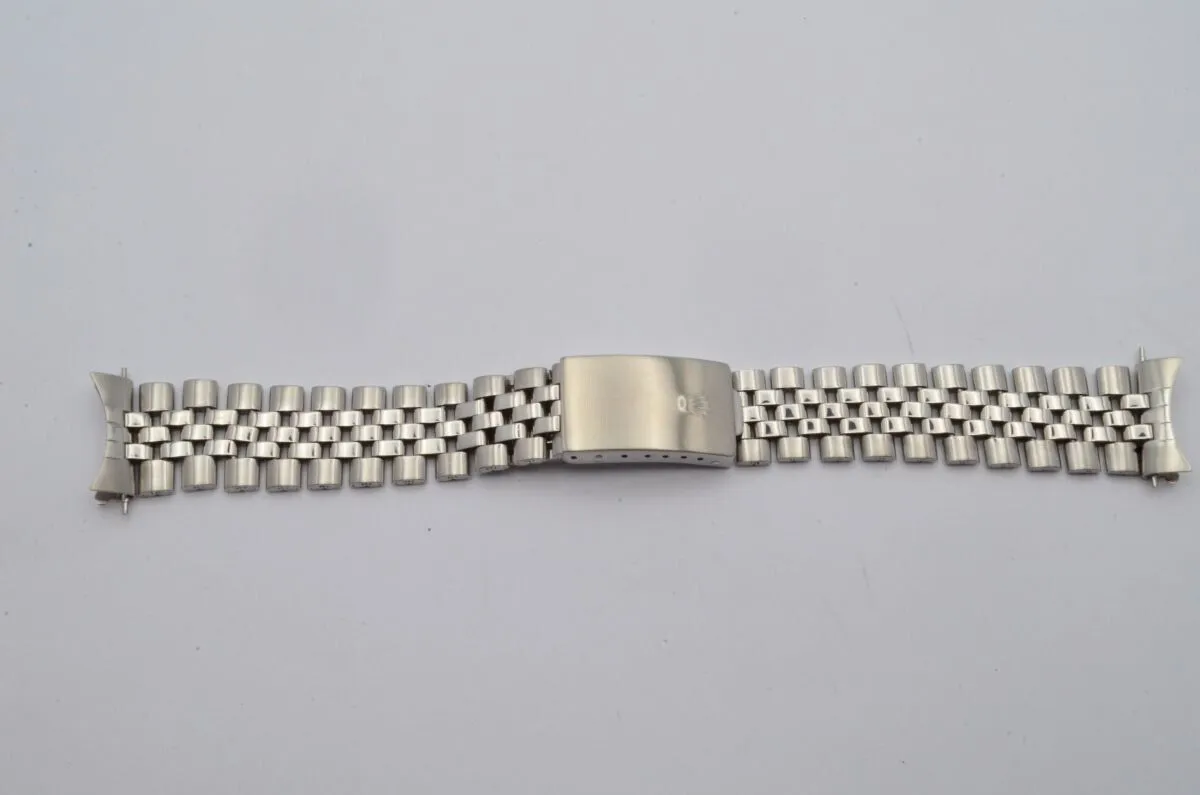
- President: A distinctive three-piece link bracelet made of precious metals, featured on the Day-Date models.
- Oysterflex: A high-performance elastomer bracelet with a flexible metal blade, providing durability and comfort.
- Bark Finish: A unique textured finish resembling tree bark, applied to some Rolex bracelets and bezels.
- Rehaut: The inner bezel that often has “Rolex” and the serial number engraved.
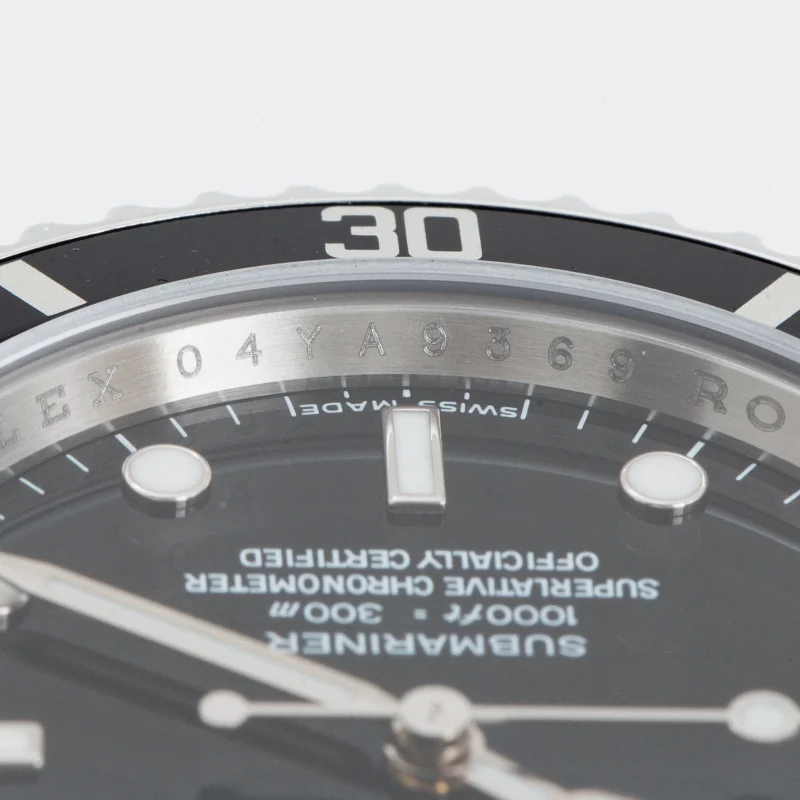
- MOP (Mother of Pearl): A natural material used for dials, offering a unique iridescent look.

- Meteorite: Rare material used for dials, featuring natural patterns from meteorites.
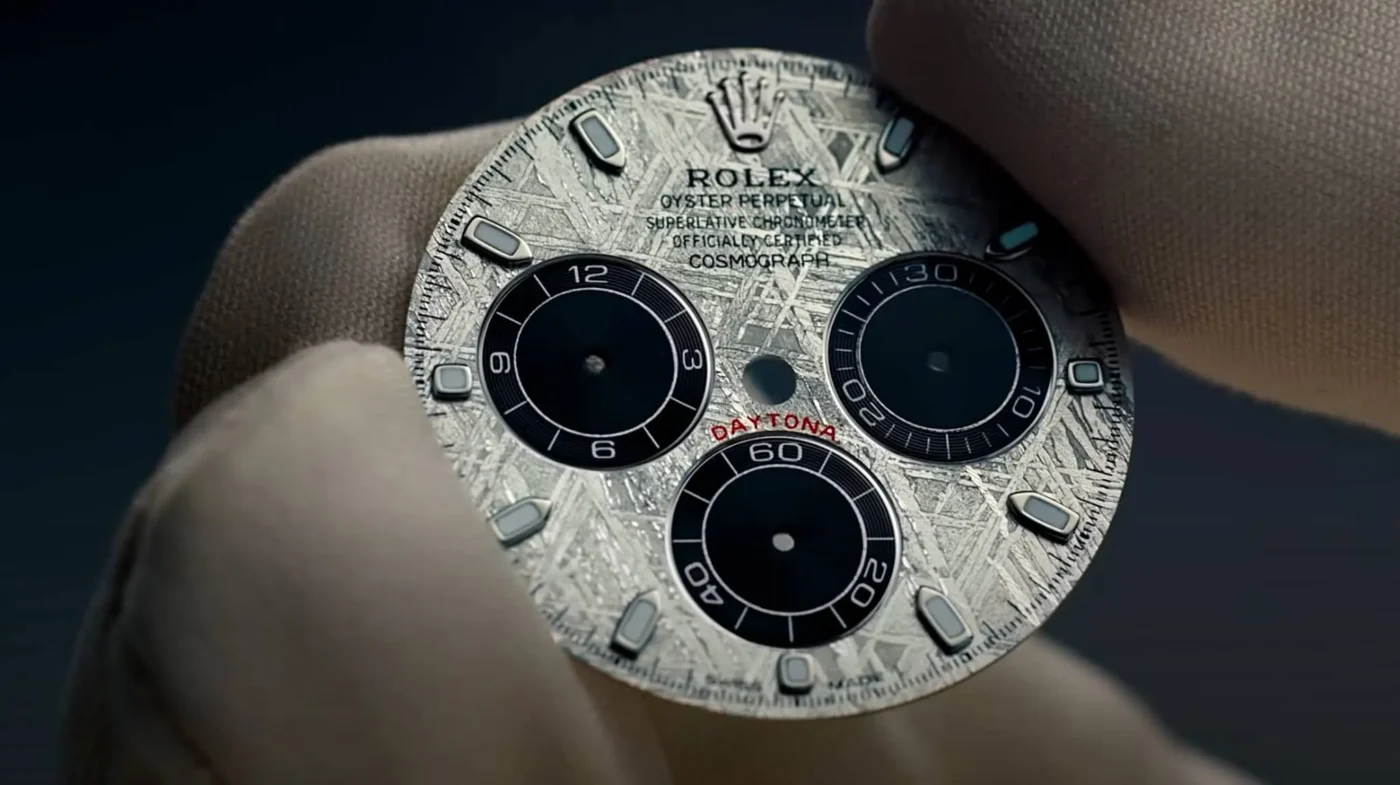
- 904L Steel: A high-grade stainless steel used by Rolex, known for its exceptional resistance to corrosion and superior finish.
- Arrowhead: A style of hands or markers shaped like an arrow, often found on certain vintage models.
- Deployant Clasp: A type of clasp that folds open, allowing the bracelet to expand and then snap shut securely.
- Hidden Clasp: A clasp design creates a seamless bracelet look.
- GMT: A complication that simultaneously allows tracking two time zones, popularized by the GMT-Master models.
- Jewels: Synthetic rubies used in watch movements to reduce friction and wear on moving parts.
- Luminova: A luminescent material used on dials and hands, replaced by Super-Luminova for improved brightness and longevity.
- Patina: The natural aging process of materials like dials and lume, often sought after in vintage watches.
- Rolesium: The combination of Oystersteel and platinum, used in Yacht-Master models.
- Sub-dials: Smaller dials within the main dial, are used for additional functions like chronographs.
- Super-Luminova: An advanced luminescent material providing a brighter and longer-lasting glow in low light conditions.
By mastering these terms, you’ll be well-equipped to recognize and understand the unique qualities that define Rolex watches. Stay tuned, as soon we will publish a more comprehensive article with Rolex terminology, you will be able to display deep knowledge of Rolex and watches collection in general.
Rolex Collections
Rolex collections are designed with distinct purposes and unique features, catering to different lifestyles and preferences. In this section, we’ll explore each collection, highlighting key characteristics that make them identifiable.
Oyster Perpetual
- Overview: The Oyster Perpetual is the essence of Rolex, known for its simple, classic design and robust construction. It represents the core principles of Rolex: precision, durability, and timeless style. A great entry-level watch, being the cheapest of the modern Rolex watches, yet having Swiss quality and precision DNA.
- Key Visual Features: Smooth bezel, clear and legible dial with stick hour markers, no date complication.
- Popular Models and Variations: Available in various sizes ranging from 28mm to 41mm, with a variety of dial colors including vibrant options like turquoise and coral red.
- Price Range: Entry-level pricing, typically starting around $5,000.
- How to Identify: Look for the absence of the date window and the clean, straightforward design.
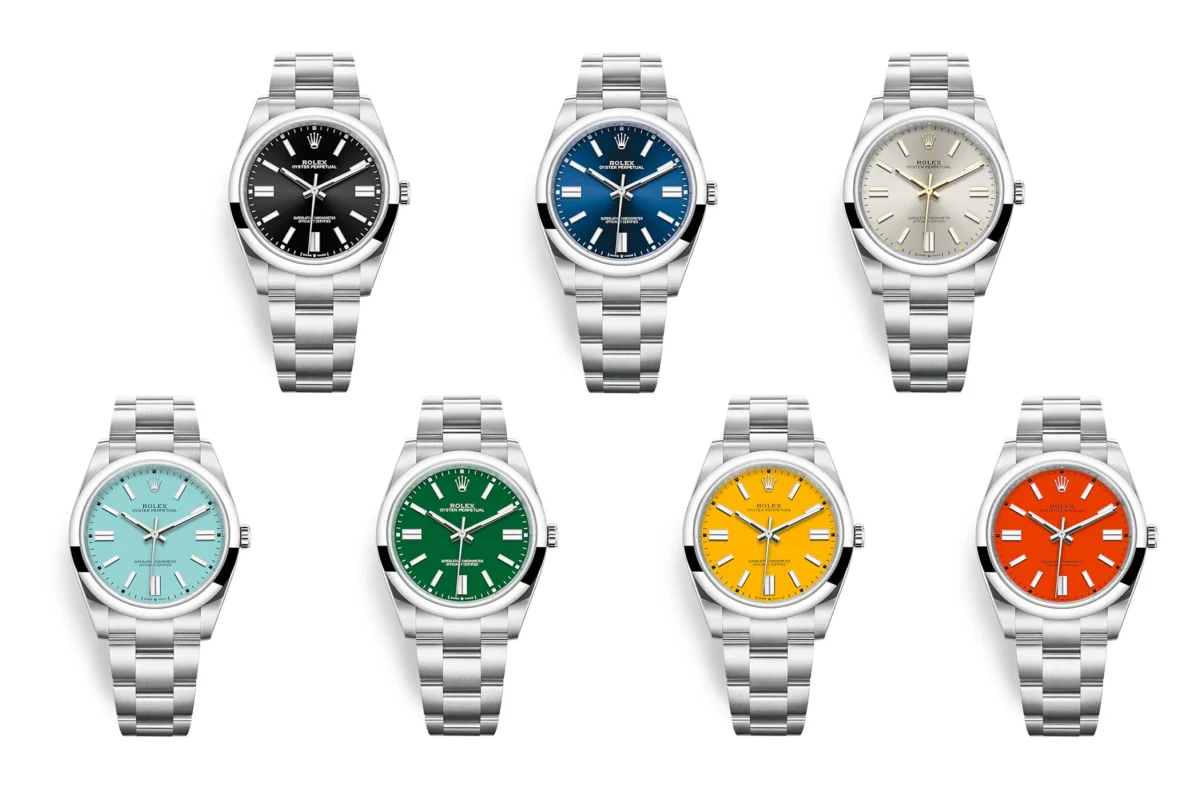
Datejust
- Overview: Known for its elegance and versatility, the Datejust is one of Rolex’s most iconic models. It’s suitable for both casual and formal wear, making it a favorite among many. The name comes from its main feature, the date, and to easily distinguish a Datejust with a Day-date, the Datejust displays just the Date, while the Day-date also displays the weekday. Now you know.
- Key Visual Features: Date window at 3 o’clock with Cyclops lens, fluted or smooth bezel, and Jubilee or Oyster bracelet.
- Popular Models and Variations: Datejust 36, Datejust 41, with options in stainless steel, two-tone, and gold. Variations include different dial colors and materials.
- Price Range: Mid-range pricing, typically starting around $7,000.
- How to Identify: The Cyclops lens over the date and the Jubilee bracelet are strong indicators.
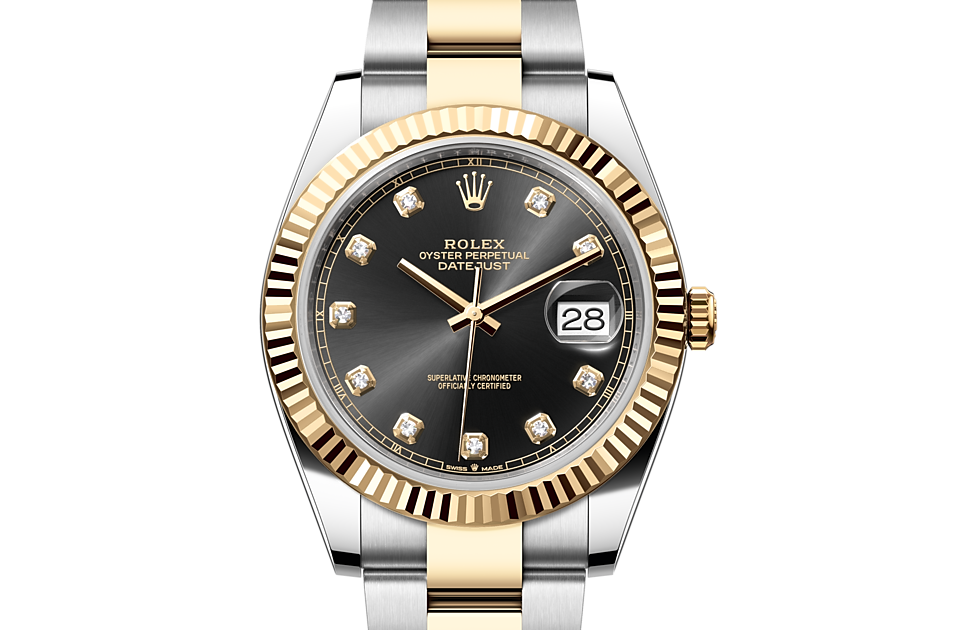
Day-Date (President)
- Overview: The Day-Date, often called the President, is a symbol of prestige and leadership. It was the first watch to display both the date and the day of the week spelled out in full when it was introduced in 1956. It was worn by many of world leaders and important figures, therefore the nickname “President”. The classic Rolex President is considered the variation with yellow-gold and champagne dial.
- Key Visual Features: Day of the week spelled out in full at 12 o’clock, date window at 3 o’clock with Cyclops lens, President bracelet.
- Popular Models and Variations: Available only in precious metals like gold and platinum, with various dial and bezel options.
- Price Range: Higher-end pricing, typically starting around $30,000.
- How to Identify: Look for the day display at 12 o’clock and the President bracelet.
- Image Placeholder: Visual guide to Day-Date models
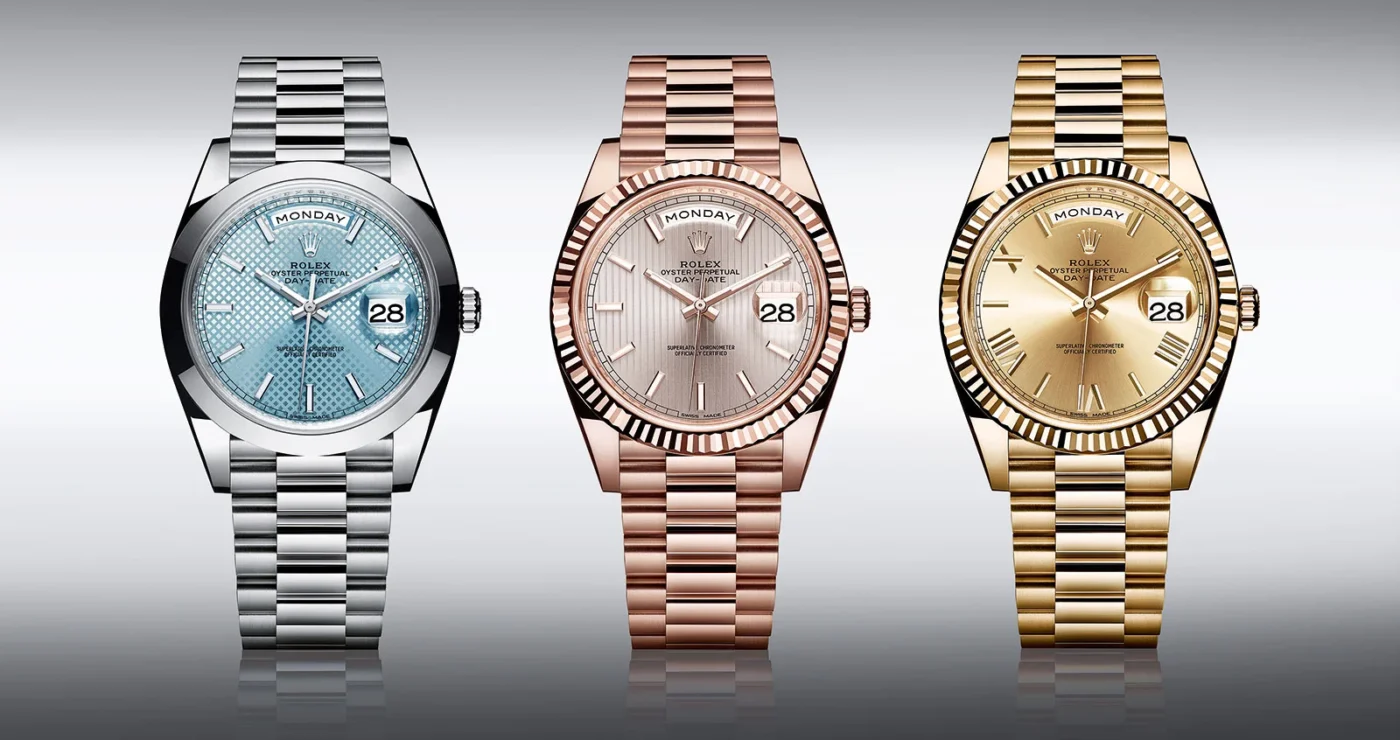
Submariner
- Overview: The Submariner is Rolex’s quintessential dive watch, renowned for its durability and design. It has become one of the most recognizable watches in the world. The most iconic is the black bezel Rolex Submariner, although there are many other colors, each of them having a unique appeal and nickname, namely Rolex Hulk, Smurf, Starbucks, Kermit
- Key Visual Features: Unidirectional rotatable bezel, luminescent markers, and a water resistance of 300 meters.
- Popular Models and Variations: Submariner Date and No Date, available in stainless steel, two-tone, and gold.
- Price Range: Mid to high-end pricing, typically starting around $8,000 MSRP, but available on the grey market for at least $14,000.
How to Identify: The rotatable bezel and luminescent hour markers are distinctive features.
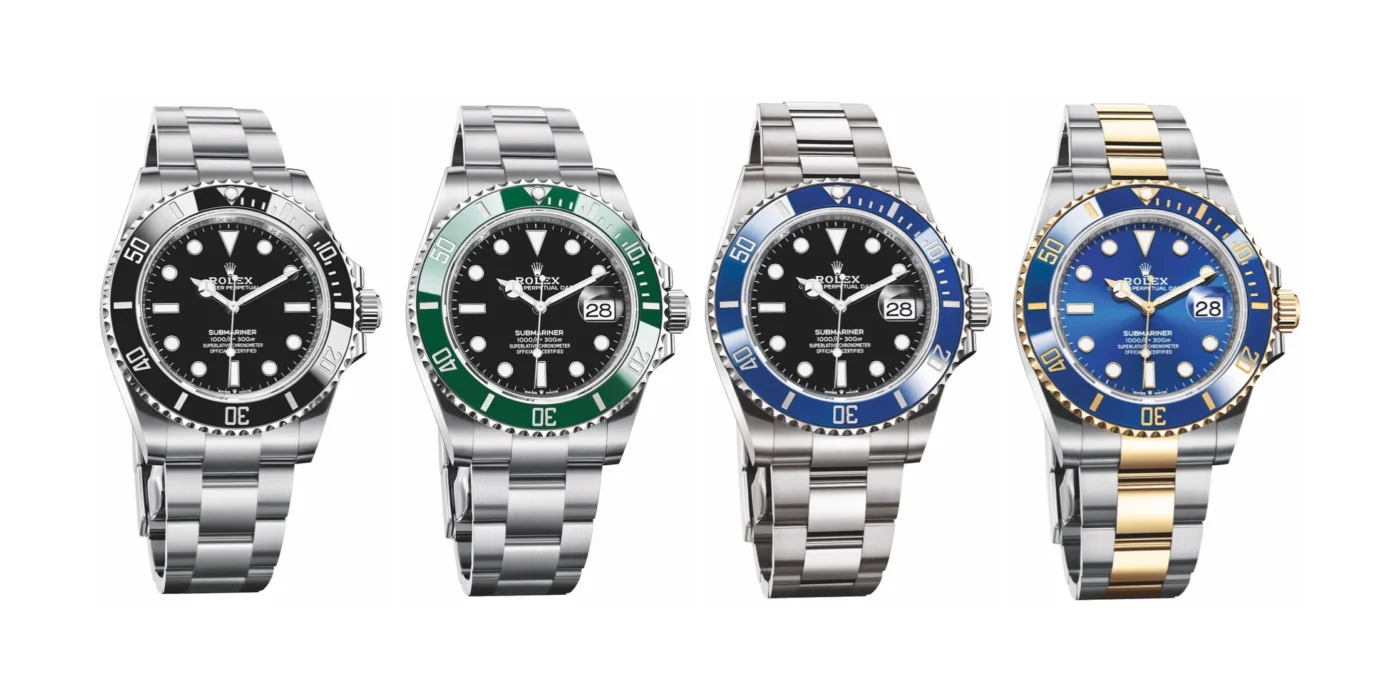
Pro tip: In 2020 Rolex decided to update the Submariner, and amongst a few of the subtle changes they made, they increased the case diameter from 40mm to 41mm. This size increase is unnoticeable, even if you hold both watches in your hands, chances are you won’t spot the difference, so we want to give you a pro tip on how to spot is a 40mm or 41mm in front of you. If during a conversation you will detect the case diameter, and therefore that it’s later than 2020 production, you will look like a real expert in the eyes of the watch owner, as not many know how to distinguish them. The 41mm Submariner watches have the Rolex crown between the “Swiss Made” words, simple as that.

GMT-Master II
- Overview: Designed for pilots and travelers, the GMT-Master II allows tracking of multiple time zones. Its colorful bezels and robust design have made it a favorite among Rolex enthusiasts. It’s probably the most diverse and talked about collection, featuring famous models like Pepsi, Coke, Rootbeer, Batman and others. Check our comprehensive guide through Rolex Nicknames.
- Key Visual Features: 24-hour rotatable bezel, added GMT hand, and usually a two-color bezel, with each color combination having a nickname. For the Rolex nicknames guide you can check our article.
- Price Range: High-end pricing, typically starting around $10,000 MSRP, but on the gray market starting around $16,000
- How to Identify: The 24-hour marks on the bezel, additional GMT hand, and most importantly mostly a two-tone bezel.
- Pro tips: The full black bezel is discontinued, but still can be found in the wild, therefore you need to be able to identify it and distinguish it from a Submariner quickly. For this, you can check the bezel, it would have 24h markings instead of second markings on the Submariner.

Explorer
- Overview: The Explorer is built for adventurers, known for its simplicity and robustness. It was designed to withstand extreme conditions and has a history linked to Mount Everest expeditions.
- Key Visual Features: Clear and legible dial with large numerals at 3, 6, and 9 o’clock, no date.
- Popular Models and Variations: Explorer I and Explorer II, with the latter featuring a date and 24-hour hand.
- Price Range: Mid-range pricing, typically starting around $6,500.
- How to Identify: The distinctive 3, 6, 9 numerals on the dial will allow you to quickly distinguish between a regular Oyster Perpetual and an Explorer.
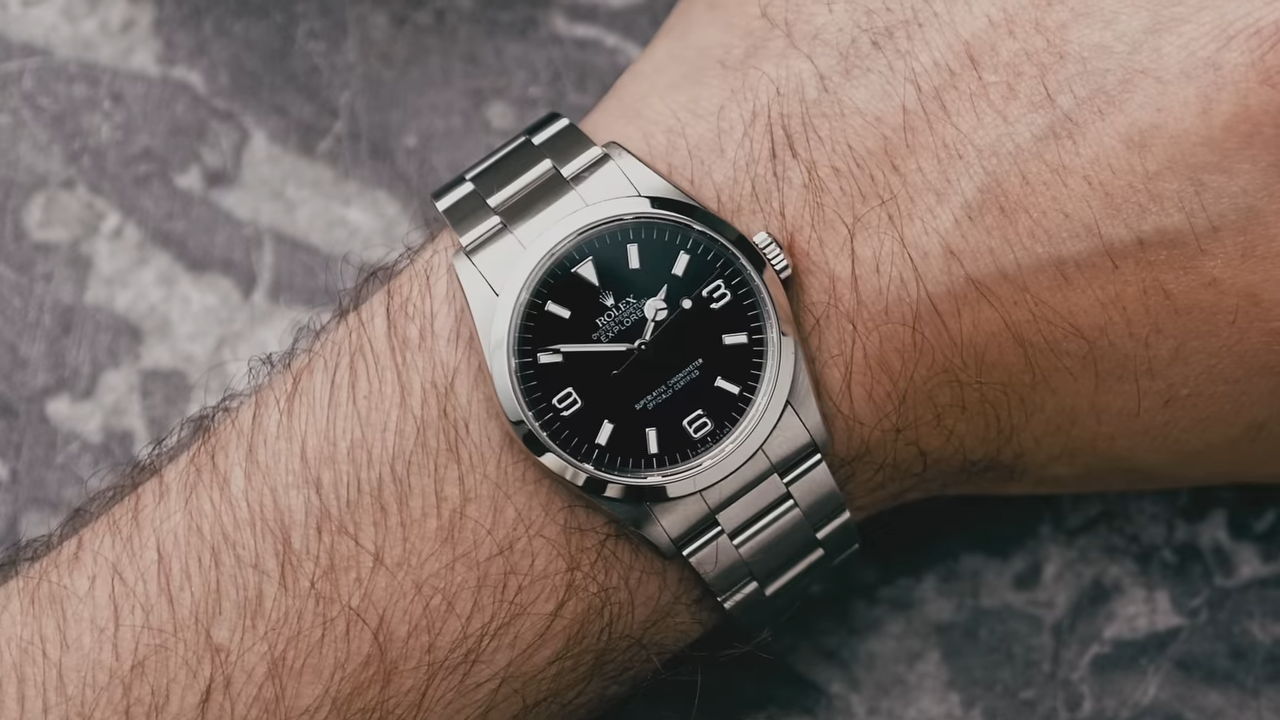 Milgauss
Milgauss
- Overview: Designed for scientists, the Milgauss is resistant to magnetic fields up to 1,000 gauss. Its unique design and technical capabilities make it a standout piece in the Rolex collection. Of course, it found an audience not only in the scientific community but also in the regular watch enthusiasts.
- Key Visual Features: Lightning bolt second-hand, green-tinted sapphire crystal.
- Popular Models and Variations: Available in stainless steel, with various dial colors including the striking Z-Blue.
- Price Range: Mid to high-end pricing, typically starting around $8,000 MSRP and going on the secondary market for north of $10,000.
- How to Identify: The lightning bolt second hand and green sapphire crystal are standout features.
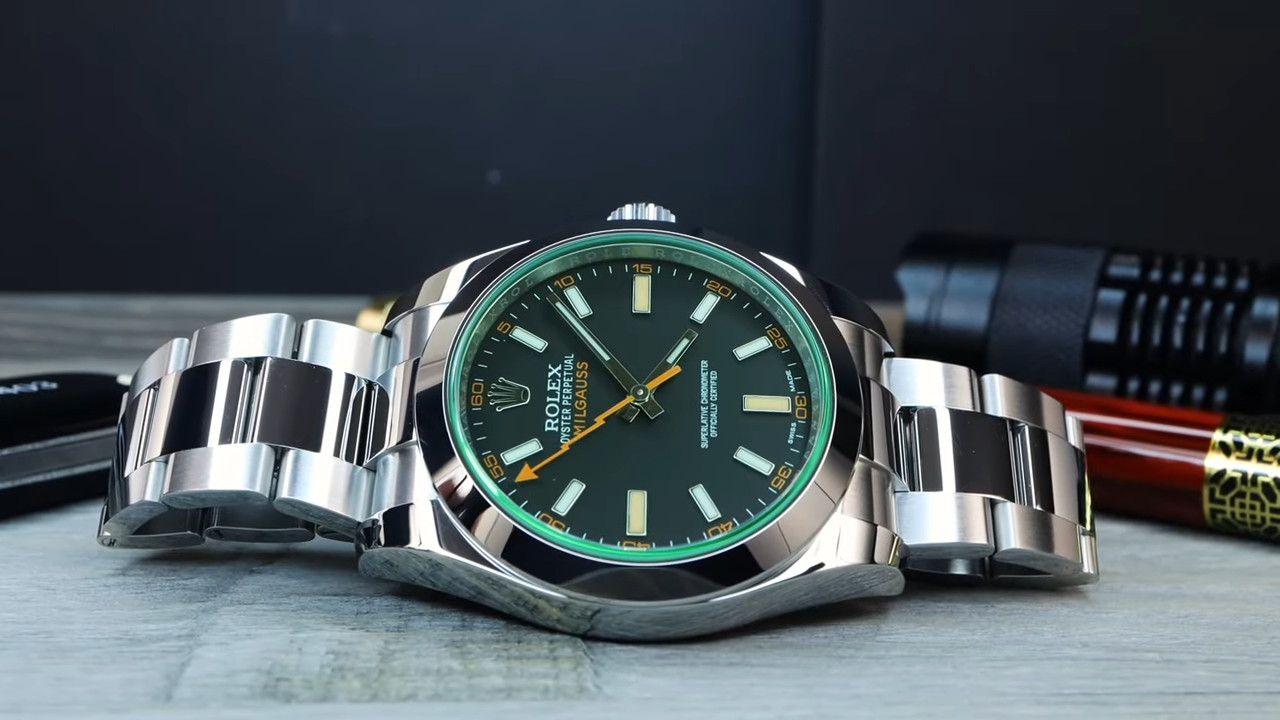
Yacht-Master
- Overview: A luxury nautical watch designed for yachting enthusiasts. The Yacht-Master combines elegance with a sporty design, suitable for both sea adventures and formal occasions.
- Key Visual Features: Bidirectional rotatable bezel, luxurious materials, often with platinum or gold.
- Price Range: High-end pricing, typically starting around $15,000 on the aftermarket.
- How to Identify: The distinctive bidirectional rotatable bezel with large, raised, and polished numerals is a standout feature of the Yacht-Master, making it easily identifiable. Additionally, the use of luxurious materials like platinum and gold adds to its distinctive look.
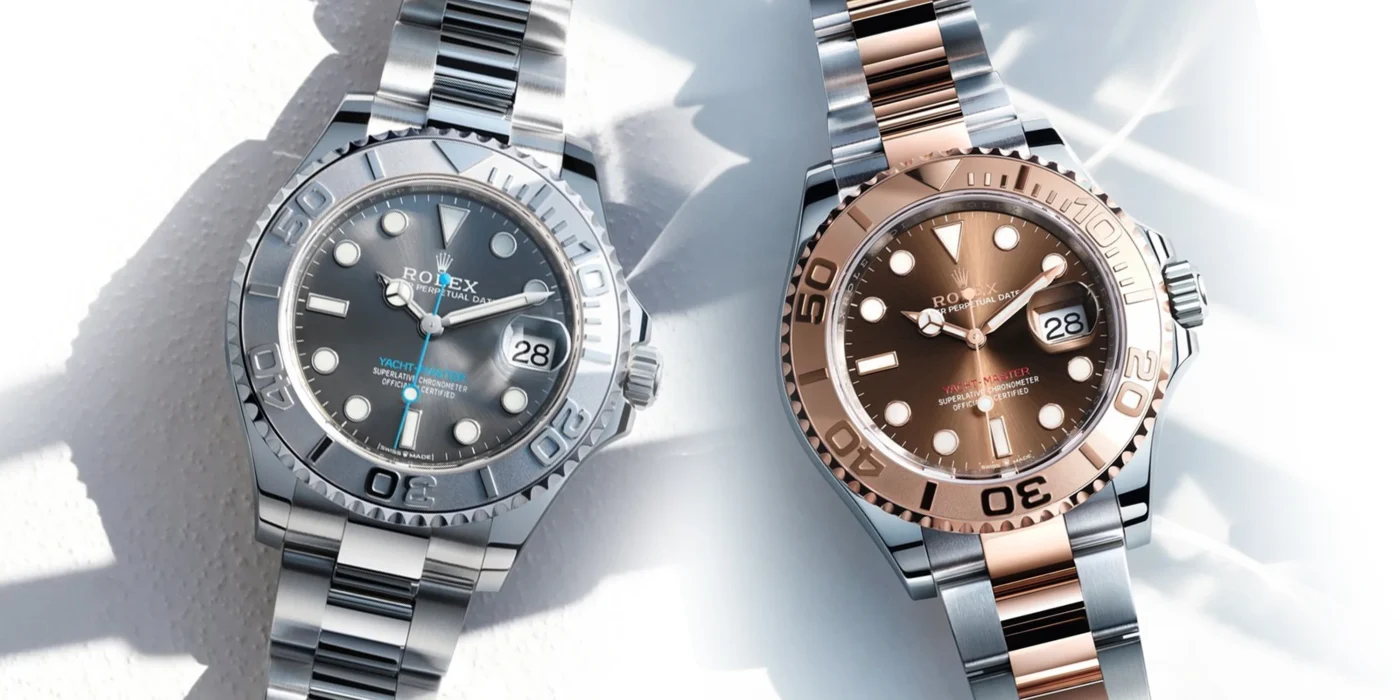
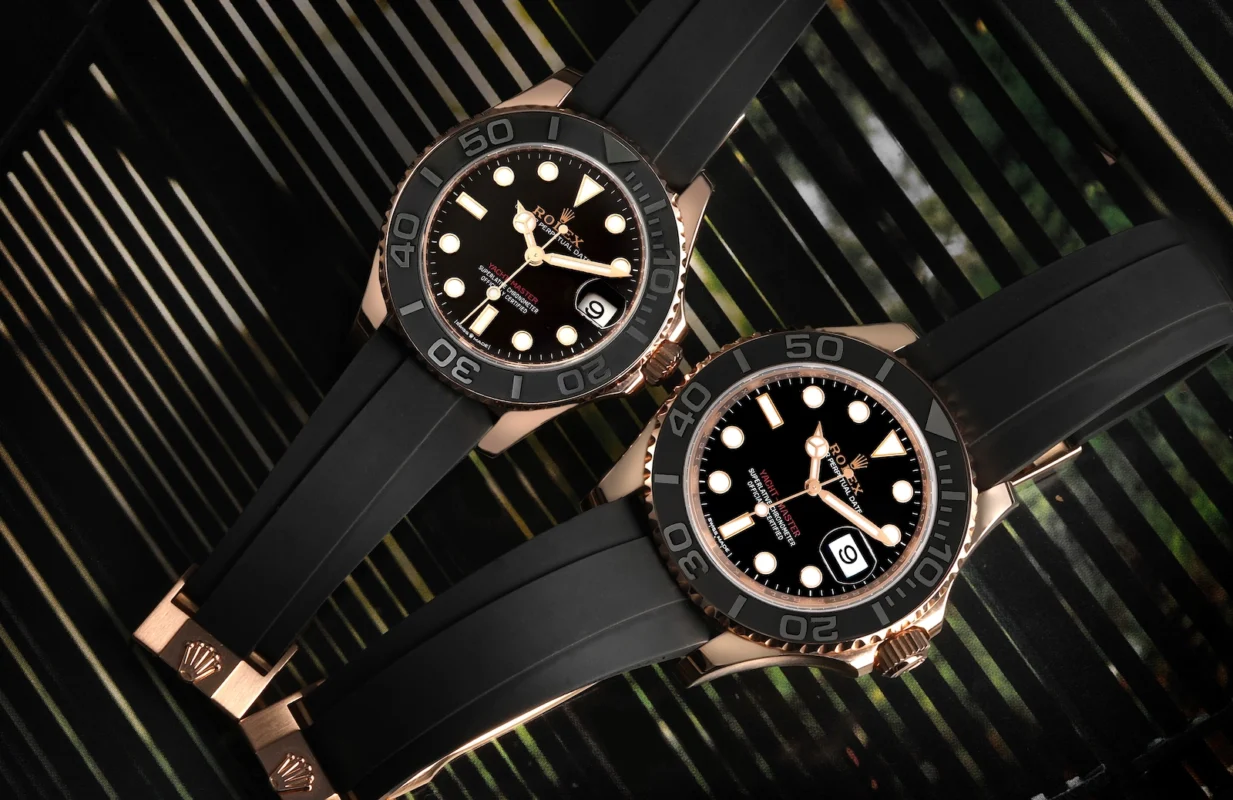
Yacht-Master II
- Overview: The Yacht-Master II is a sophisticated nautical watch designed specifically for regatta racing. It combines Rolex’s signature luxury with advanced technical features, making it an essential tool for competitive sailors. The collection was discontinued in 2024, but unlike the discontinuation of Rolex Hulk in 2020, the price didn’t see a big increase.
- Key Visual Features: Programmable countdown with mechanical memory, Ring Command bezel that interacts with the movement, larger case size, and distinctive sub-dials for regatta timing.
- Price Range: High-end pricing, typically starting around $18,000.
- How to Identify: The Yacht-Master II is easily identifiable by its larger case size and the Ring Command bezel, which features bold, blue ceramic and distinct, engraved numerals. The programmable countdown function and regatta timer sub-dials are unique to this model, setting it apart from other Rolex watches.
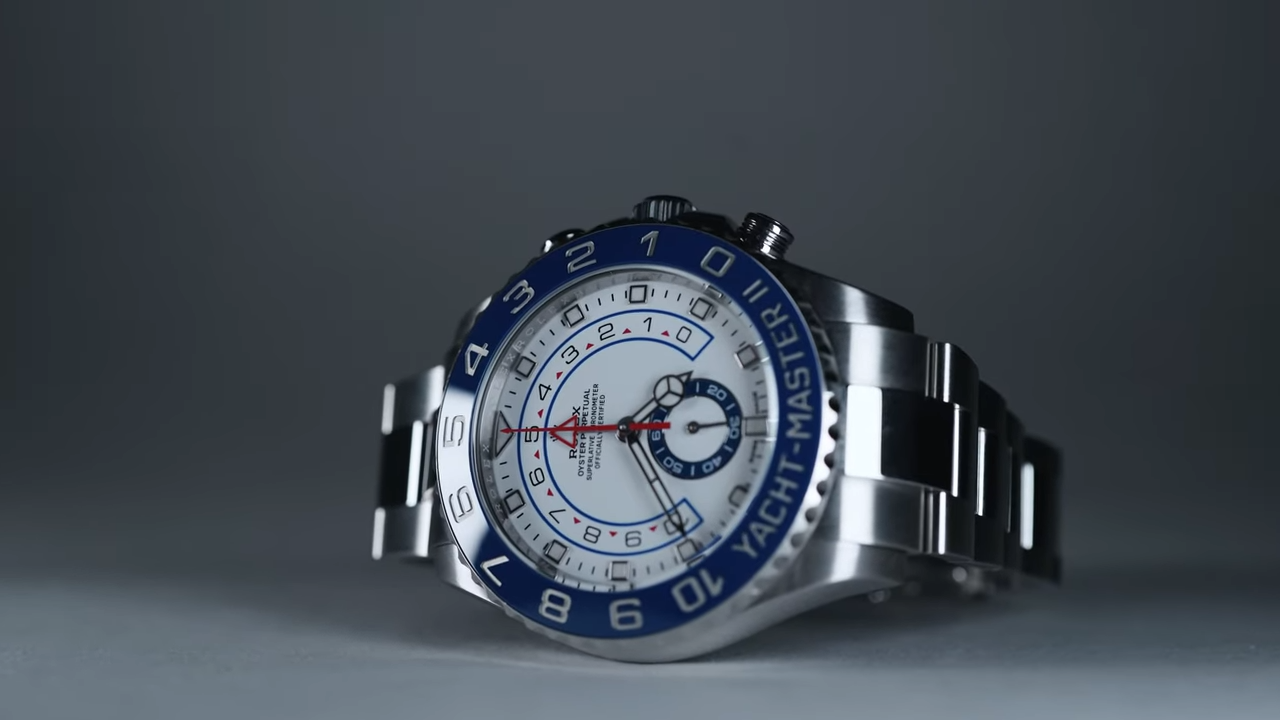
Sea-Dweller
- Overview: Professional deep-sea diving watch with enhanced water resistance. It was designed to meet the demands of professional divers working at great depths.
- Key Visual Features: Helium escape valve, robust build, water resistance up to 1,220 meters (Sea-Dweller) or 3,900 meters (Deepsea).
- Popular Models and Variations: Sea-Dweller and Deepsea.
- Price Range: High-end pricing, typically starting around $12,000.
- How to Identify: The helium escape valve and a substantial case size of 43 and 44mm. Below we will showcase the three main model variations and how to distinguish them from a Submariner. Another fun fact that most people don’t know, is that the Deepsea does not have the Cyclops Lens over the date, which makes it stand out.

The original Rolex Sea-Dweller 116660 featured a ring outside the dial mentioning it has a gas escape valve.
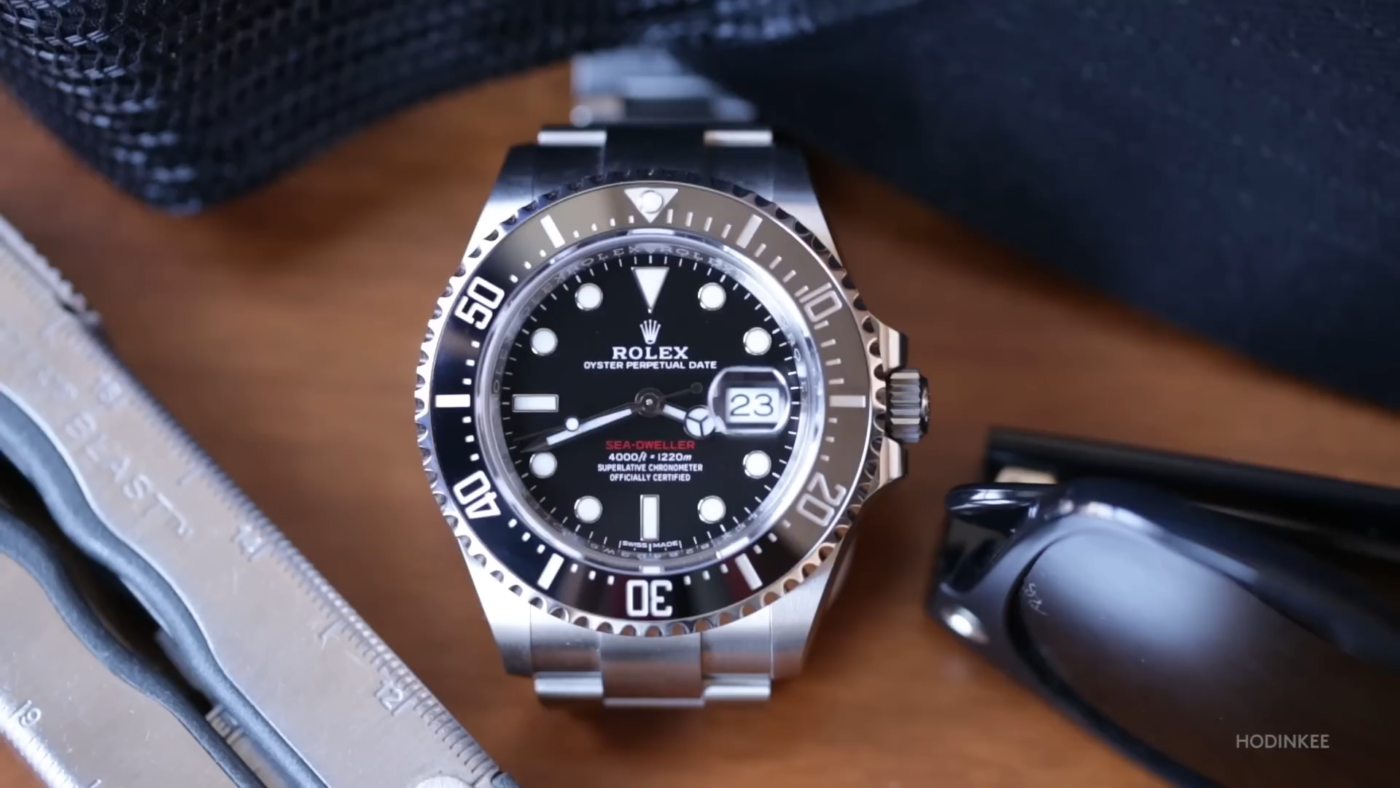
The updated Rolex Sea-Dweller 126600 doesn’t feature the white ring around the dial, and the main easy-to-spot differences between a Submariner is the larger case, which can’t always the correctly assessed by an untrained eye, and the red Sea-Dweller writing on the dial.
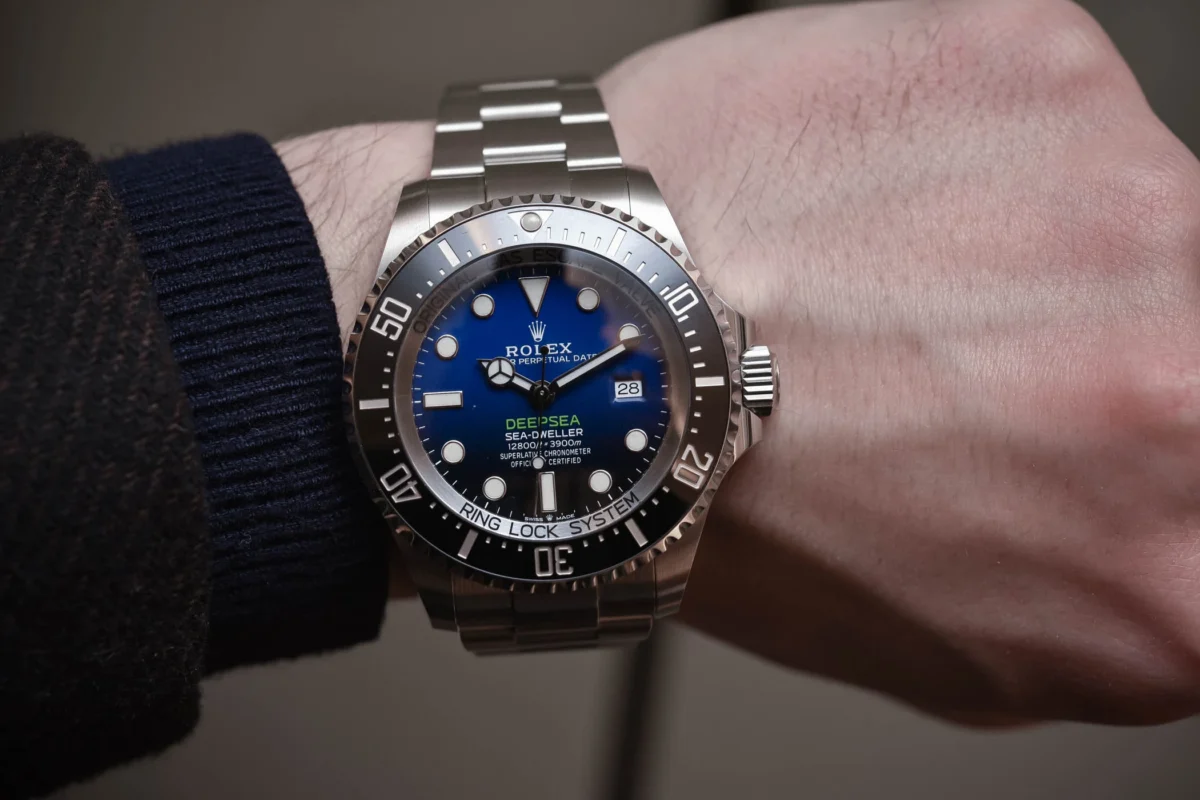
Often mistaken for being in a separate collection, the Rolex Deepsea is another variation of the Sea-Dweller, but a more extreme one, having a water resistance of up to 3900m, it is very easy to distinguish by its blue gradient on the dial.
Daytona
- Overview: The Cosmograph Daytona is one of Rolex’s most celebrated and sought-after models, originally designed for professional racing drivers. Since its introduction in 1963, the Daytona has become an iconic timepiece, renowned for its precision, durability, and stylish design. If you see someone with a Rolex Daytona, chances are, it’s not the only Rolex in his collection.
- Key Visual Features: The Daytona features a tachymetric scale on the bezel, which allows drivers to measure average speeds over a specific distance. It also has three sub-dials: a 30-minute counter at 3 o’clock, a 12-hour counter at 9 o’clock, and a small seconds counter at 6 o’clock. The pushers on the side of the case control the chronograph functions.
- Popular Models and Variations: The Daytona is available in a variety of materials including stainless steel, yellow gold, white gold, Everose gold, and platinum. Some of the most popular and rare variations include the “Paul Newman” dial, known for its unique art-deco style and contrasting colors.
- Price Range: High-end to luxury pricing, typically starting around $14,000 for stainless steel bezel and north of $30,000 for ceramic bezel variations.
- How to Identify: The Daytona can be identified by its distinctive chronograph sub-dials and the tachymetric scale on the bezel. The pushers on the side of the case are another distinguishing feature, as they control the stopwatch functions. The presence of the name “Cosmograph Daytona” on the dial, along with its sporty yet elegant design, makes it instantly recognizable.
- Unique Features and Innovations: The latest Daytona is equipped with the Rolex Caliber 4130, a self-winding mechanical chronograph movement known for its robustness and precision. The movement features a Parachrom hairspring, which offers greater resistance to shocks and temperature variations. Additionally, the watch’s screw-down pushers and crown ensure a water resistance of up to 100 meters (330 feet), making it suitable for both racing and aquatic activities.
- Historical Significance: The Daytona’s association with racing legend Paul Newman has significantly boosted its popularity. Newman’s own Daytona, which features the “Paul Newman” dial, was auctioned for a record-breaking $17.8 million in 2017, underscoring the model’s immense desirability and historical importance.
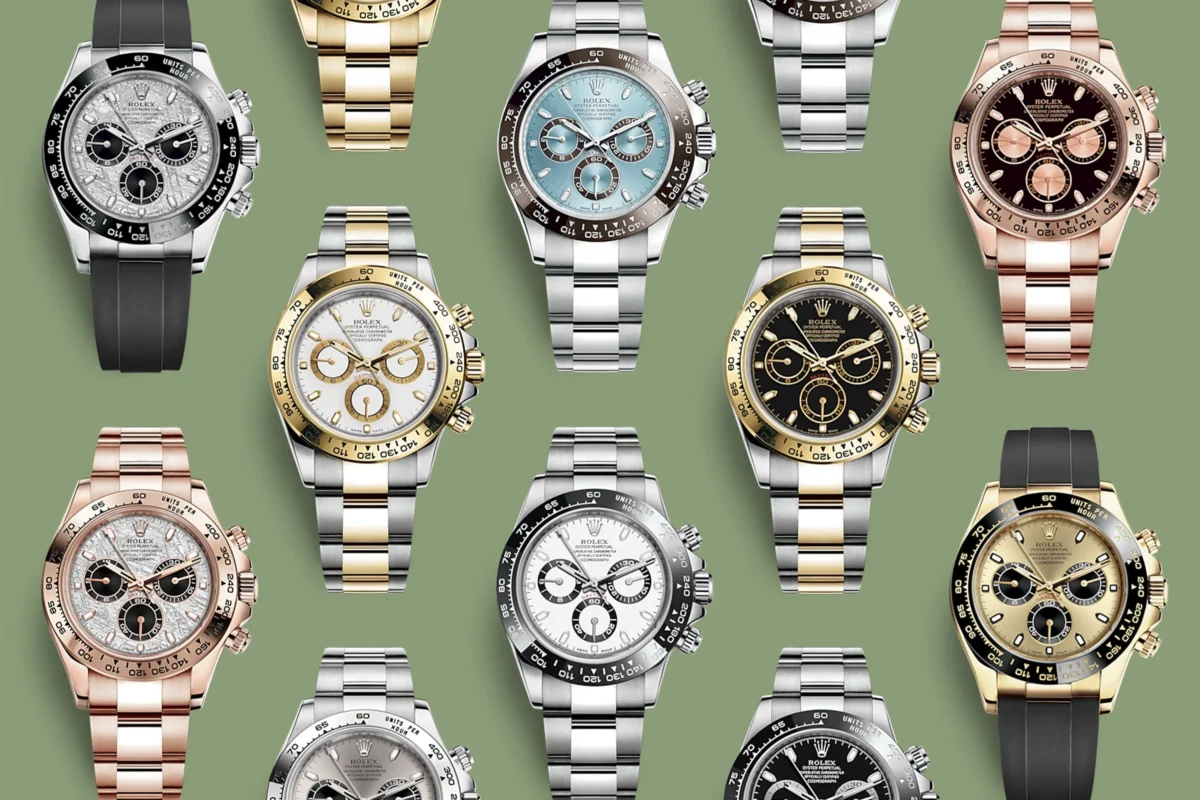
Sky-Dweller
- Overview: A complex watch designed for travelers, featuring an annual calendar and dual time zones. It combines sophisticated design with advanced functionality. Somebody wearing a Sky-Dweller is definitely an interesting person, as it’s a very special model.
- Key Visual Features: Ring Command bezel, off-center 24-hour disc, annual calendar display.
- Popular Models and Variations: Available in stainless steel, two-tone, and precious metals.
- Price Range: Luxury pricing, typically starting around $15,000.
- How to Identify: The off-center 24-hour disc and Ring Command bezel.
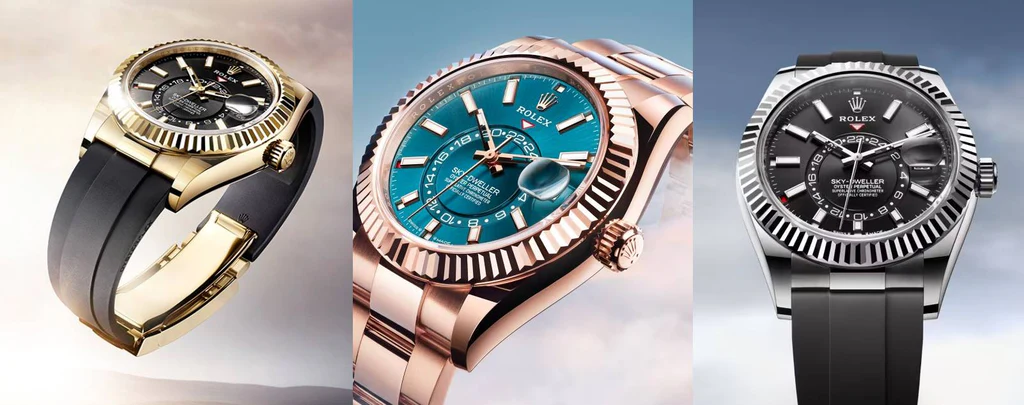
Pearlmaster
- Overview: Rolex’s jewelry watch, often adorned with diamonds and precious stones. It is the epitome of luxury and elegance within the Rolex collection. Although it is not very well received in the watch collector community, it’s found love in the aristocratic and rich cohort of mostly women.
- Key Visual Features: Elegant design, diamond settings, available in gold and platinum.
- Popular Models and Variations: Different sizes and gem settings.
- Price Range: Luxury pricing, typically starting around $50,000.
- How to Identify: The abundance of precious stones and the luxurious design.
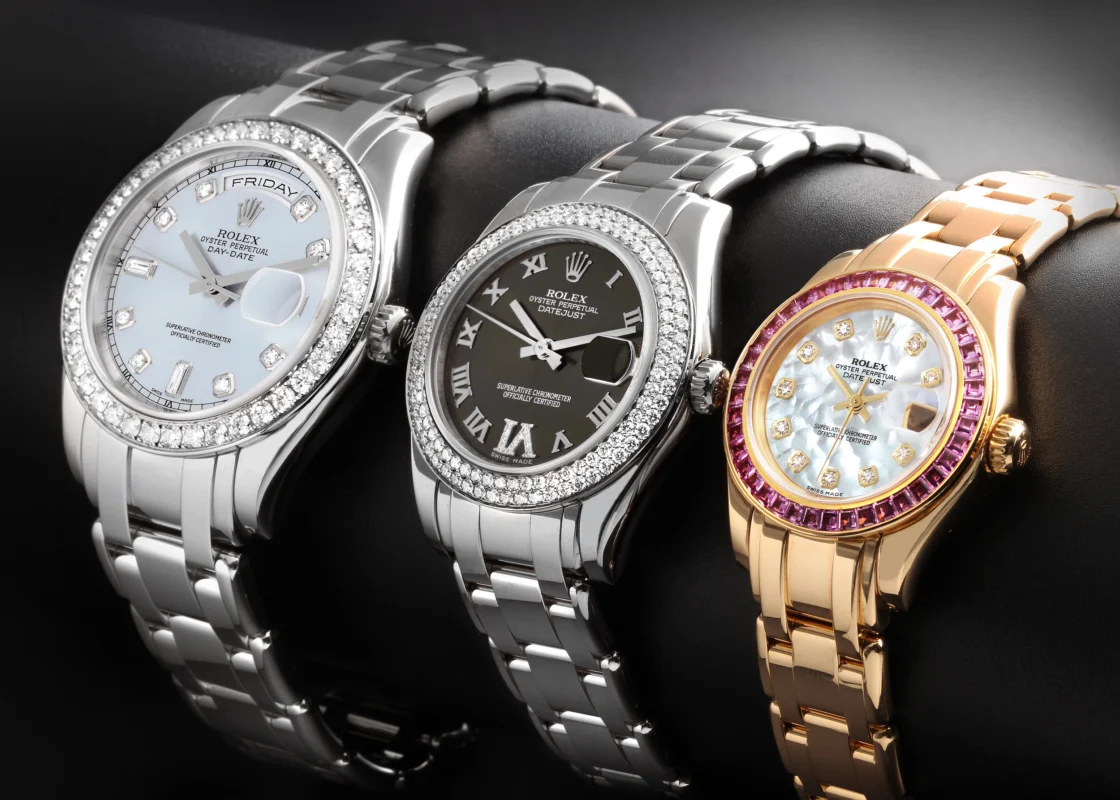
Rolex Cellini
- Overview: The Rolex Cellini collection stands as Rolex’s tribute to classicism and the art of watchmaking. Named after the Italian Renaissance artist Benvenuto Cellini, this collection emphasizes traditional elegance and sophisticated design. Rolex Cellini is considered somewhat of an outliner in the Rolex family, but does get the respect in the watchmaking community.
- Key Visual Features: The Cellini features sleek, polished cases, typically made of 18k white gold, Everose gold, or yellow gold. It often comes with leather straps, guilloché dials, and dauphine or feuille hands, reflecting its dress watch aesthetics.
- Popular Models and Variations:
- Cellini Time: Focuses on minimalist timekeeping with simple hour, minute, and second hands.
- Cellini Date: Adds a date function with an elegant date display at 3 o’clock.
- Cellini Dual Time: Features a sub-dial for a second time zone and an AM/PM indicator.
- Cellini Moonphase: Includes a moonphase display with a meteorite applique for the moon and a blue enamel disc.
- Price Range: Typically starts around $15,000 and can go upwards depending on the model and materials used.
- How to Identify: Look for the classic, refined design, precious metal cases, leather straps, and intricate dial details like guilloché patterns.
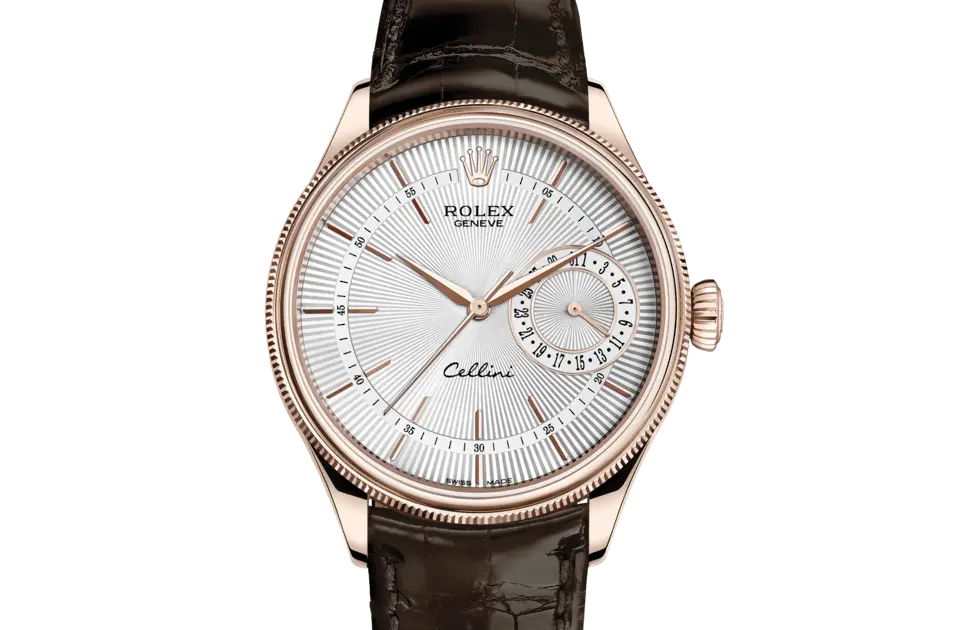
Rolex Air-King
- Overview: The Rolex Air-King pays tribute to the pioneers of flight and Rolex’s aeronautical heritage. It is a robust and functional timepiece designed for aviation enthusiasts.
- Key Visual Features: The Air-King features a distinctive black dial with large 3, 6, and 9 numerals, combined with a prominent minute scale for navigational time readings. The dial also displays the name “Air-King” in the same lettering as the original 1950s model.
- Popular Models and Variations: The modern Air-King, reference 116900, features a 40mm case made from Oystersteel, a solid-link Oyster bracelet, and is equipped with the Rolex Caliber 3131.
- Price Range: Mid-range pricing, typically starting around $6,500.
- How to Identify: The unique dial design with large numerals at 3, 6, and 9 and seconds markings instead of hour markings, combined with the distinctive “Air-King” logo, makes it easily recognizable. The 40mm Oystersteel case and Oyster bracelet are also key identifiers.
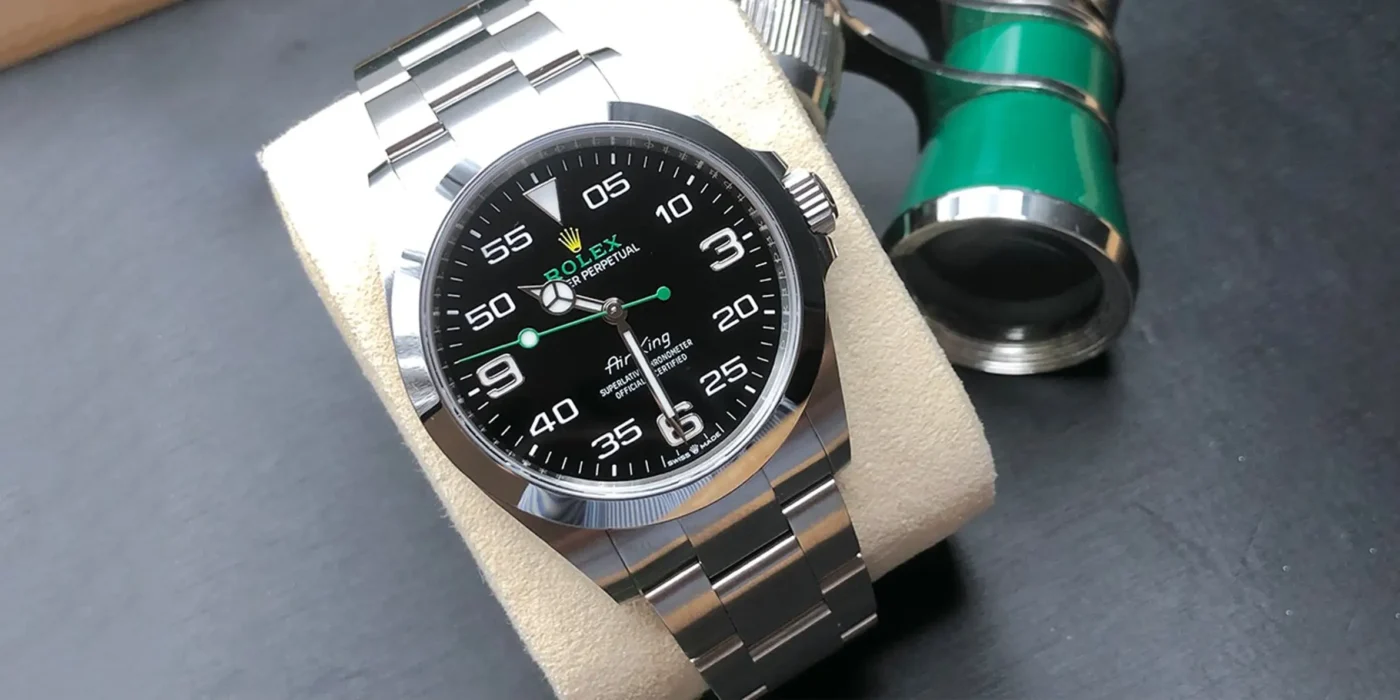
Rolex Dealers and Waiting List
Buying a Rolex, especially a highly coveted model, requires more than just visiting an authorized dealer (AD). Due to high demand and limited supply, many popular models come with extensive waitlists and necessitate building a good relationship with dealers.
The Rolex Waitlist and Dealer Relationships
For highly sought-after models like the Submariner, Daytona, and GMT-Master II, wait times can range from several months to several years. For instance, a stainless steel Daytona might have a wait time of 2 to 8 years.
Why the Wait? Rolex limits production to maintain exclusivity and ensure high quality. Despite claims of not creating artificial scarcity, the result is high demand outpacing supply. Every part of a Rolex watch, except for the hands and crystal, is made in-house, ensuring stringent quality control but limiting production capacity.
Building a Relationship with Dealers To improve your chances of obtaining a desired model:
- Loyalty: Regularly purchase other items from the dealer to build a history.
- Consistency: Maintain regular contact and visits to stay on their radar.
- Genuine Interest: Show a real appreciation for the brand, not just an intent to resell.
- Patience and Politeness: Dealers are more likely to favor polite and patient customers.
Impact on After-Market Pricing
The high demand and limited availability have fueled a robust grey market where watches are sold at premiums. Popular models like the Daytona and GMT-Master II often fetch significantly higher prices in the aftermarket. For example, a stainless steel Daytona can be sold for more than double its retail price on the grey market due to immediate availability.
Authorized dealers often prioritize long-time clients, creating a tiered system where new buyers may struggle to access the most sought-after models. This dynamic drives up aftermarket prices as collectors and buyers are unwilling to wait to turn to grey market dealers.
In summary, securing a coveted Rolex requires patience, strategic purchasing, and building a solid relationship with dealers. Understanding these dynamics can enhance your chances of obtaining your desired watch directly from an AD, while also explaining the inflated prices seen on the grey market.
With this information in hand, you can confidently hold a conversation with a Rolex enthusiast, or simply identify an ice breaking discussion with any Rolex owner. To add some extra level of expertise, check out our article on How to spot a fake Rolex, which will equip you with tricks to easily detect cheaper Rolex fakes.


